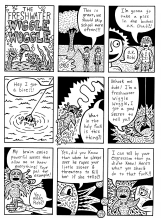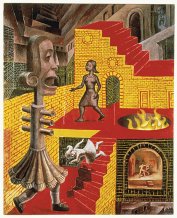| Revista Umělec 2004/4 >> The Monstrous Muteness of František Skála | Lista de todas las ediciones | ||||||||||||
|
|||||||||||||
The Monstrous Muteness of František SkálaRevista Umělec 2004/401.04.2004 Ondřej Váša | Teoría | en cs |
|||||||||||||
|
Skála v Rudolfinu
Rudolfinum Gallery, Prague October 10, 2004 – January 2, 2005 After a few days of observing its destructive traces I stood over it, heard its weakening breath and I was drowning in a sea of despair unable to help it in any way. It extinguished and I remained there in total darkness.— František Skála Once upon a time, there was a golden era for junk collectors under communism. Iron Sundays were a time when people could offer disused metal junk for a conscientious recycling scheme. Those days are long gone. But František Skála is still being found by things; and he keeps finding them. He strips them of their civilian names and endows them with new ones, or he holds them back in favor of anonymity. Skála at the Rudolfinum, the title of the recent Prague exhibition, is appropriate: Bring such a stubborn artist to that neo-Renaissance space and test the quaintness of his work—and recognize how great his work is. Literally. The high ceilings of the halls and conceptual control allowed Skála a suitably generous space to express himself with objects adapted for the exact needs of the exhibition in the Rudolfinum. Whereas a retrospective could easily have been a general recapitulation of this artist’s career, this presentation was a unique performance, a presentation of Skála’s curious cabinet of living curiosities. Many of the works were born recently. Many were manufactured for and tailored to the very place they were located (only The Spy was exiled to the stairs, for technical reasons). As such it was a truly representative exhibition of Skála’s creative method, one that is founded on mutual encounters that involve finishing—raising of things from their original status to have a new, sublime presence. Often, when Skála’s work is described, emphasis tends to be on its close association with nature, using playfulness, wit and a sense of detachment. Such attributes tend to speak of the look of the artifacts, or they are a commentary on how they affect people; but seldom is there inquiry into the fundamentals on which the work’s form is grounded. Indeed, it isn’t easy to identify that which links these eccentric exhibits that include macroscopic photos, disciplined natural objects, installations, funny Saigon cars, and diaries. A particularly intriguing aspect of Skála’s work is surely the romantic essence of the exposed thingness of his objects or installations. There is a seriousness there—one without meaning, but not altogether meaningless. Articulated, or creatively exposed thingness was a crucial theme in 20th century art. Because Skála’s works don’t render thingness in any thematic way, we are unable to speak about thingness employed within the strategies delimiting the art work or its reception. In the case of these procedures the thingness remains substantially non-definite, a mere perspective that is hardly the formal result of a creative act. And although the choice of exhibits in question or their imitations can not be described as accidental (of course, one can always work with accidents), it is obvious that the same result can be gained with other, often random means. Pick up a shovel or a bottle-rack and one is just like the other; any way you look at them, they are simply ready-mades. Skála’s artifacts taps into a symbiosis of disused mundane objects’ clear identity and their surroundings, crafting a new authentic figure. In the same way that individual components retain something of their essential substance, the resulting expression is no artistic game of incompatible opposites (nature vs. art, utilitarian thingness vs. artistic value). But the material inverse of the used object is simultaneously transformed to become the obverse of the expression: Used components are uncovered as things enabling a new platform of discourse, a new signifier. Any allegorical or metaphorical reading of Skála’s works would be a blind way of interpretation. Similarly, an attempt at exact interpretation falls short the moment individual works are exposed to connotations of meaning where an opening for interpretation might be alluded to, but whose horizon can never be attained. The specificity of Skála’s objects is shown in the degree to which they exceed the meaning of that thingness with which they had been previously associated; at the same time the works acquire entirely new possibilities. Objects, organically comprised of foundlings from rubbish bins or from things that are worn-out, have in this context had their de facto romantic essence revealed, at least if they are set in relation to romantic notions of fossils or totems. This nostalgic dimension of Skála’s objects, that refers to historicity of things and within the continuity of this history to their fleetingness, is related in his work through the fossilized form of the objects used. In the final expression of the whole work these reach a totemic nature1 that taps into the intimate and lively connection both with nature and associated meanings with things. An artistic action, a singular expression of every given object is thus transformed into a monstrous work—in the sense used by Foucault, in contrast to the notion of fossil. Things that, within their historicity, transform into fossils and become imprints of lost life and eras, cluster together with Skála’s creative method into monsters that are, through their singular artistic nature, unrepeatable exceptions, imaginary bastards of rusty thingness. Andre Breton once said that Marcel Duchamp raised everyday objects to a dignified level by making them ready-mades. Let’s ignore the imprecision of this remark and use it as an apt paraphrase—Skála raises rusty things to a monstrous meaningful silence. 1. On the theme of totem and fossil viz W.J.T. Mitchell, Romanticism And The Life Of Things, in: Critical Inquiry 28, The University Of Chicago 2001.
01.04.2004
Artículos recomendados
|
|||||||||||||
|
04.02.2020 10:17
Letošní 50. ročník Art Basel přilákal celkem 93 000 návštěvníků a sběratelů z 80 zemí světa. 290 prémiových galerií představilo umělecká díla od počátku 20. století až po současnost. Hlavní sektor přehlídky, tradičně v prvním patře výstavního prostoru, představil 232 předních galerií z celého světa nabízející umění nejvyšší kvality. Veletrh ukázal vzestupný trend prodeje prostřednictvím galerií jak soukromým sbírkám, tak i institucím. Kromě hlavního veletrhu stály za návštěvu i ty přidružené: Volta, Liste a Photo Basel, k tomu doprovodné programy a výstavy v místních institucích, které kvalitou daleko přesahují hranice města tj. Kunsthalle Basel, Kunstmuseum, Tinguely muzeum nebo Fondation Beyeler.
|







.jpg.detailThumb.png)

.jpg.thumb.png)
























 We Are Rising National Gallery For You! Go to Kyjov by Krásná Lípa no.37.
We Are Rising National Gallery For You! Go to Kyjov by Krásná Lípa no.37.
Comentarios
Actualmente no hay comentariosAgregar nuevo comentario